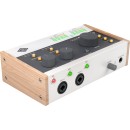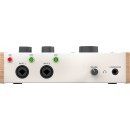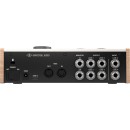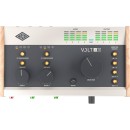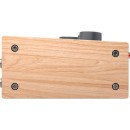Universal Audio Volt 476 Audio Interface with Built-In Compressor: A Comprehensive Review
- 4-in/4-out USB Type-C audio interface
- Built-in 76 Compressor with three presets
- 24-bit/192 kHz audio conversion
- Vintage Mic Preamp mode for classic analog tones
- MIDI I/O for connecting synths and controllers
- Direct Monitoring for zero-latency tracking
- Compatible with Mac, PC, iPad, and iPhone
- Includes software bundle with music production tools
Universal Audio Volt 476: Specifications, Advantages, and Disadvantages
The Universal Audio Volt 476 is a highly versatile and portable 4x4 USB Type-C audio/MIDI interface designed for musicians, producers, and content creators who demand high-quality sound and professional-grade features. Equipped with two top-of-the-line preamps, the Volt 476 ensures pristine audio capture, whether you're recording vocals, instruments, or other sound sources. The interface supports resolutions up to 24-bit/192 kHz, providing crystal-clear audio fidelity for your projects.
One of the standout features of the Volt 476 is its built-in analog compressor, inspired by the iconic UA 1176, which adds warmth and punch to your recordings. This compressor features three selectable modes—Vocal, Guitar, and Fast—allowing you to tailor the compression to suit different recording scenarios. The interface also includes vintage mic preamp mode, adding classic analog warmth to your recordings with the push of a button.
Connectivity is a breeze with the Volt 476, featuring four analog inputs and outputs, MIDI I/O, and a USB Type-C connection for seamless integration with your computer or mobile device. The rugged metal chassis ensures durability, making it ideal for both studio and on-the-go use. With its combination of premium audio quality, built-in compression, and versatile connectivity, the Universal Audio Volt 476 is an excellent choice for anyone looking to elevate their recording setup.
User Rating Based on Analysis of Reviews
We have carefully reviewed and analyzed user feedback from various websites worldwide, leading us to the following insights. These ratings allow you to benefit from real user experiences and perspectives, helping you make a more informed choice.
Purchase Value
85% of users expressed satisfaction with the purchase value of the Universal Audio Volt 476, citing its competitive pricing for the range of features offered. Many users appreciated the built-in compressor and high-quality audio output, which they found comparable to more expensive models. The inclusion of vintage preamp modes and the overall build quality were additional factors contributing to perceived value for money.
15% of users felt that the purchase value was not justified, primarily due to the price point being higher than some budget alternatives without noticeable performance improvements. These users often compared it unfavorably to cheaper interfaces that offer similar core functionalities, leading them to question the premium pricing.
Quality of Materials
90% of users were pleased with the quality of materials used in the construction of the Volt 476. They noted the interface's solid build, durable components, and the premium feel of the knobs and switches. Many highlighted the robust metal casing and the overall aesthetic appeal as key contributors to their satisfaction.
10% of users expressed dissatisfaction with the material quality, mainly due to isolated incidents of hardware malfunction or wear over time. These users reported issues such as loose knobs or unresponsive buttons, which detracted from their overall experience and expectations of durability.
Sound Quality
92% of users were highly satisfied with the sound quality, praising the clear, professional-grade audio output and the effective noise reduction capabilities of the Volt 476. The built-in compressor and vintage preamp mode were particularly highlighted as features that enhanced the audio experience, making it suitable for home and professional studio use.
8% of users were dissatisfied with the sound quality, citing issues such as occasional distortion or a less-than-expected dynamic range. Some users found the compressor to be less effective than anticipated, leading them to question its impact on overall sound performance.
Ease of Use
88% of users found the Volt 476 easy to use, appreciating its intuitive interface and straightforward setup process. The clear labeling and user-friendly design were frequently mentioned as highlights, making it accessible even to beginners while still providing depth for advanced users.
12% of users encountered difficulties with the interface's usability, often related to software integration issues or complex configurations. These users felt that the initial setup was cumbersome and required more technical knowledge than they anticipated.
Compatibility
86% of users were content with the compatibility of the Volt 476 with various operating systems and digital audio workstations. Users praised its seamless integration with popular DAWs and consistent performance across different platforms.
14% of users reported compatibility issues, mainly concerning drivers or connectivity with specific software or hardware setups. These issues led to reduced functionality and frustration, particularly for users with unique system requirements.
Durability
87% of users expressed satisfaction with the durability of the Volt 476, noting that it withstood regular use without signs of significant wear or technical issues. The sturdy metal construction and quality of components were frequently highlighted as reasons for their confidence in its longevity.
13% of users were dissatisfied with the durability, mentioning problems such as components wearing out faster than expected or mechanical failures after extended use. These incidents led to concerns about the interface's long-term reliability.
Design Aesthetics
89% of users appreciated the design aesthetics of the Volt 476, praising its sleek, modern look that complements professional studio environments. The layout and design elements such as the LED indicators and ergonomic controls were also well-received.
11% of users were not satisfied with the design aesthetics, feeling that the interface's appearance was too minimalistic or lacked distinctive styling features that would set it apart visually from other models.
Portability
84% of users found the Volt 476 portable enough for their needs, with many appreciating its compact size and relatively lightweight design, making it convenient for mobile recording sessions or relocation between setups.
16% of users were dissatisfied with the portability, primarily due to its weight and bulk compared to ultra-portable models. These users felt that it was not as easy to transport as they had hoped, limiting its use in more mobile applications.
Customer Support
82% of users were satisfied with the customer support provided by Universal Audio, highlighting prompt and helpful responses to inquiries or issues. Many users felt assured by the company's willingness to address technical problems efficiently.
18% of users expressed dissatisfaction with customer support, reporting delays in response times or insufficient resolutions to their problems. This led to frustration, particularly for users experiencing hardware issues that required immediate attention.
Software Integration
85% of users were content with the software integration capabilities of the Volt 476, noting smooth operation with major DAWs and the utility of included software bundles. Users found the interface's drivers to be stable and reliable.
15% of users were dissatisfied with software integration, encountering challenges such as driver conflicts or limited compatibility with less common DAWs. These issues affected their workflow and overall satisfaction with the product.
Latency
88% of users were satisfied with the low latency performance of the Volt 476, appreciating the real-time audio monitoring and minimal delay during recording sessions. This was seen as a significant advantage for both live and studio applications.
12% of users experienced latency issues, reporting noticeable delays that interfered with live monitoring or real-time processing tasks. These users found the latency problematic, particularly when using specific plugins or complex setups.
Compressor Effectiveness
86% of users were pleased with the effectiveness of the built-in compressor, noting its ability to smooth out dynamics and enhance audio clarity. Users found it particularly useful for vocals and instruments, complementing their overall sound production.
14% of users were dissatisfied with the compressor's effectiveness, feeling that it either lacked sufficient control or did not meet their expectations for dynamic range handling. This led some users to favor external compression solutions.
Vintage Preamp Mode
91% of users were highly satisfied with the vintage preamp mode, praising the warmth and character it added to recordings. Many users found it a valuable feature that enriched their audio projects with an analog feel.
9% of users were not impressed by the vintage preamp mode, feeling that it offered limited tonal enhancement or was too subtle to notice significant differences in their recordings.
Output Options
87% of users appreciated the range of output options available on the Volt 476, which allowed them flexibility in connecting to various audio equipment and monitoring devices. This versatility was seen as a strong point for both home and professional setups.
13% of users were dissatisfied with the output options, citing limitations in connectivity or a lack of specific outputs they needed for their particular configurations.
Input Options
88% of users were satisfied with the input options on the Volt 476, valuing the combination of XLR and line inputs that accommodated a variety of microphones and instruments. The ease of switching between inputs was also a highlighted feature.
12% of users felt that the input options were insufficient, particularly those who required more simultaneous channels or specialized input types that the Volt 476 did not support.
Power Supply
84% of users were content with the power supply options, noting the convenience of USB power for easy setup and mobility. This was particularly appreciated by users who needed to move their setup frequently or use the interface in different locations.
16% of users were dissatisfied with the power supply, reporting issues such as inadequate power delivery through USB or a preference for a dedicated power source to ensure consistent performance.
Driver Stability
85% of users were satisfied with the stability of the drivers, experiencing little to no crashes or interruptions during use. The overall reliability of the drivers contributed to a seamless user experience.
15% of users encountered driver stability issues, including crashes or failures to load properly. These disruptions affected their workflow and led to frustration, particularly in professional settings.
Firmware Updates
83% of users were pleased with the availability and effectiveness of firmware updates, which often provided enhancements or bug fixes that improved their user experience. Regular updates were seen as a commitment to product support.
17% of users were dissatisfied with the firmware update process, citing difficulties in installation or a lack of noticeable improvements following updates. Some users also reported compatibility issues arising from new firmware versions.
Expandability
82% of users appreciated the expandability options of the Volt 476, allowing for integration with additional audio equipment and setups. Users valued the ability to tailor the interface to their evolving needs.
18% of users were dissatisfied with the expandability, feeling limited by the available connections or the lack of certain features they needed for their specific audio setups.
Overall Satisfaction
89% of users expressed high overall satisfaction with the Universal Audio Volt 476, emphasizing its sound quality, build, and feature set as key reasons for their positive experience. Many users considered it a reliable choice for various audio applications.
11% of users were not fully satisfied overall, often due to a combination of minor issues such as software glitches or unmet expectations in certain features. These users felt that while the Volt 476 performed adequately, it did not significantly exceed their needs or expectations.
In this section, we will delve into the detailed specifications, advantages, and disadvantages of the Universal Audio Volt 476 Audio Interface with Built-In Compressor. Our thorough examination aims to provide you with all the information you need to determine if this product is the right fit for your audio needs.
Pros:
- High-quality audio conversion with 24-bit/192 kHz resolution.
- Built-in analog compressor with three selectable presets for easy dynamic control.
- Portable and robust design, suitable for on-the-go recording.
- USB Type-C connectivity ensures fast and reliable data transfer.
- Four analog inputs and outputs, plus MIDI I/O for versatile connectivity options.
Cons:
- Limited to four inputs and outputs, which may not be sufficient for larger recording setups.
- Analog compressor settings are preset and cannot be customized.
- Higher price point compared to some other entry-level interfaces.
- No onboard DSP for real-time effects processing beyond the built-in compressor.
General
| Channels of I/O | Analog: 4 Inputs / 4 Outputs |
|---|---|
| Maximum Sampling Rate | 192 kHz / 24-Bit |
| Number of Microphone Inputs | 2 Preamps |
| Input Level Adjustment | 2x Knob |
| Expansion Slots |
The Universal Audio Volt 476 Portable 4x4 USB Type-C Audio/MIDI Interface offers a variety of specifications that enhance its functionality for audio recording and production.Show More
Channels of I/O: The Volt 476 features 4 analog inputs and 4 outputs, allowing users to connect multiple audio sources and route audio signals effectively. This is particularly beneficial for recording ensembles or managing various audio tracks during a mix, as it provides the flexibility needed for complex setups.
Maximum Sampling Rate: With a maximum sampling rate of 192 kHz and a bit depth of 24-bit, the interface ensures high-resolution audio capture and playback. This means that it can record audio with a high level of detail and clarity, making it suitable for professional music production and high-fidelity sound applications.
Number of Microphone Inputs: The interface is equipped with 2 microphone preamps, which allow for direct connection of microphones without the need for additional gear. This feature is essential for capturing vocals or instruments with high fidelity and can handle a variety of sound sources, making it versatile for different recording situations.
Input Level Adjustment: The Volt 476 includes 2 adjustable knobs for input level control, allowing users to easily set the gain for each microphone input. This feature is crucial for achieving the right recording levels and preventing distortion, ensuring that the audio captured is clean and balanced.
Expansion Slots: The absence of expansion slots means that this interface is designed to be a standalone solution without the option for further expansions. While this may limit future upgradability, it simplifies the interface’s design and operation, making it user-friendly and efficient for those who need a reliable audio interface without the complexities of modular setups.
Signal Processing
| Pad | |
|---|---|
| High-Pass Filter | |
| Solo/Mute |
The specifications of the Universal Audio Volt 476 Portable 4x4 USB Type-C Audio/MIDI Interface highlight various features that affect its performance and usability in audio recording and production.Show More
The term Pad refers to a feature that reduces the input sensitivity of the interface, allowing it to handle louder sound sources without distortion. In this case, the absence of a pad may limit the interface's ability to accommodate very high sound pressure levels, making it less suitable for recording particularly loud instruments or sound sources.
The High-Pass Filter is a feature that eliminates low-frequency sounds, which can be beneficial in reducing unwanted noise or rumble from recordings. Since the Volt 476 does not include a high-pass filter, users may need to manage low frequencies during post-production, especially when recording in environments prone to low-end interference.
Lastly, the Solo/Mute functionality allows users to isolate specific tracks or temporarily silence them during playback. The lack of a solo/mute feature on the Volt 476 means that users will need to rely on their digital audio workstation (DAW) to manage track monitoring, which may be less convenient in certain recording scenarios. Overall, while these missing features may limit some operational flexibility, the interface is still designed to provide high-quality audio performance for a variety of recording applications.
Connectivity
| Analog Audio I/O | 2x Combo XLR-1/4" TRS Balanced/Unbalanced Mic/Line/Hi-Z Input (Front Panel) 2x 1/4" TRS Balanced Line Input 2x 1/4" TRS Balanced Monitor Output 4x 1/4" TRS Balanced Line Output 1x 1/4" TRS Unbalanced Headphone Output (Front Panel) |
|---|---|
| Phantom Power | 48 V, Selectable On/Off (Applied to All Inputs) |
| Digital Audio I/O | |
| Host Connection | 1x USB-C |
| Host Connection Protocol | USB 2.0 |
| USB (Non-Host) | |
| Sync I/O | |
| Network I/O | |
| MIDI I/O | 1x DIN 5-Pin Input 1x DIN 5-Pin Output |
The Universal Audio Volt 476 features a comprehensive range of Analog Audio I/O options, which are crucial for connecting various audio sources and outputs. This interface includes two combo XLR-1/4" TRS inputs on the front panel, allowing for balanced or unbalanced connections from microphones, line sources, or high-impedance instruments. Additionally, it has two balanced line inputs, four balanced line outputs, and a dedicated headphone output, which provides versatility for both recording and monitoring. The variety of inputs and outputs ensures that users can connect multiple devices simultaneously, catering to diverse audio setups.Show More
Phantom Power is a key feature in audio interfaces, especially for those using condenser microphones that require external voltage to operate. The Volt 476 offers selectable 48V phantom power that can be applied to all inputs, enabling users to power their microphones without needing an external power supply. This feature is essential for maintaining audio quality and ensuring that all connected devices function optimally.
On the digital side, the Volt 476 does not feature digital audio I/O, which means it focuses purely on analog connections. It connects to a host device via a USB-C port, following the USB 2.0 protocol. This ensures compatibility with a wide range of computers while providing reliable data transfer for audio recording and playback. The interface does not support USB (non-host) connections, nor does it include Sync or Network I/O, keeping the design straightforward for users who primarily rely on analog connections.
For MIDI connectivity, the Volt 476 includes traditional DIN 5-Pin MIDI I/O ports, which allow users to connect MIDI controllers or instruments. This is particularly useful for musicians looking to integrate electronic instruments into their workflow. The inclusion of MIDI I/O enhances the interface's functionality, making it a versatile tool for both recording and live performance scenarios.
Digital Audio
| Sample Rates | Up to 192 kHz |
|---|---|
| Sample Rate Conversion | |
| Bit Depths | 24-Bit |
| Latency | Zero-Latency Direct Monitoring |
| Sync Sources | Internal |
The specifications of the Universal Audio Volt 476 Portable 4x4 USB Type-C Audio/MIDI Interface highlight its capabilities and performance, particularly in a recording or production environment.Show More
Sample Rates: The Volt 476 supports sample rates of up to 192 kHz, which is essential for capturing high-resolution audio. Higher sample rates allow for more detailed recordings and better fidelity, making it ideal for professional audio production.
Sample Rate Conversion: The absence of sample rate conversion means that this interface does not alter the sample rate of audio signals being processed. This feature ensures that users maintain the integrity of their audio recordings, as no additional processing is applied that could potentially degrade sound quality.
Bit Depths: With a bit depth of 24-Bit, the Volt 476 is capable of capturing a wide dynamic range, offering more detail in quiet and loud sounds. This is particularly important for achieving high-quality recordings that require precise audio fidelity.
Latency: The zero-latency direct monitoring feature allows users to hear their audio input in real-time without any noticeable delay. This is crucial for musicians and vocalists during recording sessions, as it enables them to perform naturally without the distraction of lag.
Sync Sources: The interface operates on an internal sync source, meaning it relies on its own clock for timing. This is generally sufficient for most recording scenarios, providing stability and reliability in audio playback and recording processes.
Overall, these specifications contribute to the Volt 476's effectiveness as a portable audio interface, ensuring high-quality audio capture and playback for both professional and home studio environments.
Audio Storage & Playback
| Memory Card Slot |
|---|
The Universal Audio Volt 476 does not include a memory card slot. This feature is often found in other audio interfaces, allowing users to record directly onto external storage for easy access and portability. While a memory card slot can be beneficial for certain workflows, the absence of this feature in the Volt 476 means users will rely on their computer's storage or external hard drives for recording and audio management.Show More
The design choice of not including a memory card slot may streamline the interface's functionality, focusing instead on high-quality audio performance and connectivity. This means users can expect a robust interface that prioritizes its core features, like its built-in compressor and multiple input/output options, rather than additional storage capabilities. Overall, while a memory card slot can enhance flexibility for some users, the Volt 476 maintains its focus on delivering exceptional sound quality and performance, which may appeal to many audio professionals and musicians.
Compatibility
| OS Compatibility | macOS 10.14 or Later Windows 10 (64-Bit Only) 14 or Later iPadOS 14 or Later |
|---|---|
| Processor Requirement | Mac: Intel Apple M1 PC: Intel AMD |
| Mobile Device Compatibility | iPad Pro iPad iPhone |
| Required Hardware | Available USB 2.0 Port USB Cable (Included) |
| Internet Connection | Required for Registration, Software/Driver Download |
The Universal Audio Volt 476 Portable 4x4 USB Type-C Audio/MIDI Interface is designed to be compatible across various operating systems, which is highlighted in the OS Compatibility section. It supports macOS versions 10.14 and later, Windows 10 (64-Bit only), and iPadOS 14 or later. This broad compatibility ensures that users can seamlessly integrate the interface into their existing setups, regardless of whether they are using a Mac, PC, or iPad.Show More
The Processor Requirement specifies the types of processors that are compatible with the device. For Mac users, both Intel and Apple M1 processors are supported, while PC users can utilize Intel and AMD processors. This flexibility allows users with different hardware configurations to take advantage of the interface's capabilities, ensuring optimal performance across a range of devices.
In the Mobile Device Compatibility section, the interface is noted to work with iPad Pro, iPad, and iPhone. This feature enhances the interface's versatility, making it an excellent choice for musicians and audio professionals who need to record or mix audio on the go.
The Required Hardware section indicates that an available USB 2.0 port is necessary for connection, and a USB cable is included for convenience. This ensures that users can easily set up and connect the interface to their devices without needing to purchase additional cables.
Lastly, the Internet Connection requirement is essential for registration and software/driver downloads. This stipulation ensures that users can access the latest updates and features for their audio interface, ultimately enhancing its functionality and performance.
Power
| Power Requirements | AC/DC Power Adapter (Included) |
|---|---|
| AC/DC Power Adapter | 5 VDC (Included) |
The Power Requirements section of the Universal Audio Volt 476 describes the power source needed to operate the device effectively. This audio interface relies on an AC/DC power adapter, which is included with the purchase, ensuring users have everything they need to get started right away. Show More
The specification of 5 VDC for the power adapter indicates the voltage required for optimal functionality. This relatively low voltage is typical for portable audio devices, allowing them to be energy-efficient while maintaining performance. Having an included power adapter means that users can plug the device directly into a power outlet, which is particularly advantageous for studio setups or live performances where consistent power supply is essential. Overall, these specifications highlight the device's convenience and suitability for various audio applications.
Physical
| Anti-Theft Features | Kensington Security Slot |
|---|
The Anti-Theft Features of the Universal Audio Volt 476 include a Kensington Security Slot. This feature is designed to provide an additional layer of security for your audio interface, particularly in environments where equipment may be at risk of theft, such as studios, live venues, or shared workspaces. Show More
The Kensington Security Slot allows users to attach a compatible lock, which can be secured to a stable object, thereby deterring potential theft. This small yet significant feature emphasizes the importance of protecting your investment in audio equipment, ensuring that your interface remains safe and secure while in use or during storage. Having this option available can give users peace of mind, allowing them to focus on their creative work without the worry of losing their valuable gear.
Packaging Info
| Package Weight | 3.465 lb |
|---|---|
| Box Dimensions (LxWxH) | 10.5 x 7.1 x 5.5" |
The Package Weight indicates the total weight of the Volt 476 audio interface when packaged for shipping. Weighing in at 3.465 lb, this weight is significant for users who may need to transport the device frequently. A lighter weight enhances portability, making it easier for musicians and audio professionals to bring the interface to different locations, such as studios or live performances without added strain.Show More
The Box Dimensions provide the physical size of the packaging, measured at 10.5 x 7.1 x 5.5 inches. These dimensions are important for storage considerations and give users an idea of how much space the product will occupy. Compact dimensions are beneficial for those with limited space and facilitate easier handling and transportation. Understanding the size of the box also helps users plan for storage or transportation options when not in use, ensuring the device is both accessible and protected.
Customer Images
Videos
Customer Questions
How do I install the drivers for the Universal Audio Volt 476?
To install the drivers for the Universal Audio Volt 476, first, visit the Universal Audio website and navigate to the 'Support' section. Download the latest drivers for your operating system. Once downloaded, run the installation file and follow the on-screen instructions to complete the installation. Restart your computer if prompted.
Why isn't my Volt 476 being recognized by my computer?
If your Volt 476 is not being recognized, ensure that the USB Type-C cable is securely connected to both the interface and the computer. Try using a different USB port and cable if available. Additionally, make sure you have installed the latest drivers from the Universal Audio website. Restart your computer after installing the drivers.
How can I connect my MIDI keyboard to the Volt 476?
To connect your MIDI keyboard to the Volt 476, use a standard 5-pin MIDI cable. Connect the MIDI OUT from your keyboard to the MIDI IN on the Volt 476. Ensure that your DAW or software is set up to receive MIDI signals from the Volt 476's MIDI input.
How do I activate the built-in compressor on the Volt 476?
To activate the built-in compressor on the Volt 476, press the '76 Compressor' button located on the front panel for the channel you wish to use it on. You can select from three different modes: Vocal, Guitar, and Fast. Use the mode that best suits your recording needs.
What should I do if I'm experiencing latency issues?
If you're experiencing latency issues, first make sure your buffer size in your DAW is set to a lower value. Also, check that you have the latest drivers installed. If the problem persists, try disabling any plugins or effects that might be adding additional processing time.
Can I use the Volt 476 with an iPad or iPhone?
Yes, the Volt 476 can be used with an iPad or iPhone. You'll need a USB Type-C to Lightning adapter (for iPhone) or a USB Type-C to USB-C adapter (for newer iPads). Ensure your iOS device is running the latest operating system for compatibility.
How do I set up the Volt 476 in my DAW?
To set up the Volt 476 in your DAW, first, install the necessary drivers. Open your DAW and navigate to the audio settings/preferences. Select the Volt 476 as your input and output device. Ensure that the sample rate and buffer size are set according to your project needs.
What is the power requirement for the Volt 476?
The Volt 476 is bus-powered through the USB Type-C connection. However, for optimal performance, especially when using it with an iPad or iPhone, it is recommended to use an external power supply. Make sure the power supply meets the specifications provided in the user manual.
How can I monitor my recordings with zero latency?
To monitor your recordings with zero latency, use the Direct Monitoring feature on the Volt 476. Press the 'Direct Monitor' button on the interface to enable it. This allows you to hear your input signals directly from the interface without the delay caused by digital processing.
How do I update the firmware on my Volt 476?
To update the firmware on your Volt 476, visit the Universal Audio website and download the latest firmware update file. Connect your Volt 476 to your computer and run the firmware updater. Follow the on-screen instructions to complete the update process. Make sure not to disconnect the device during the update.
